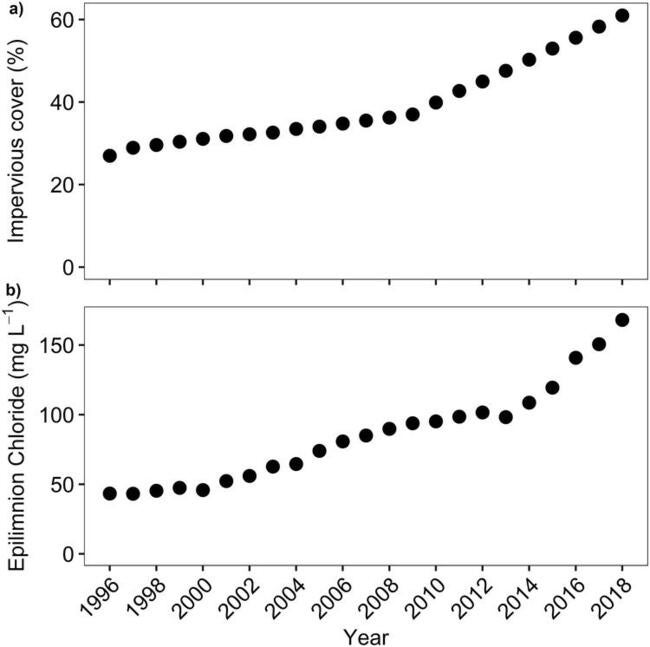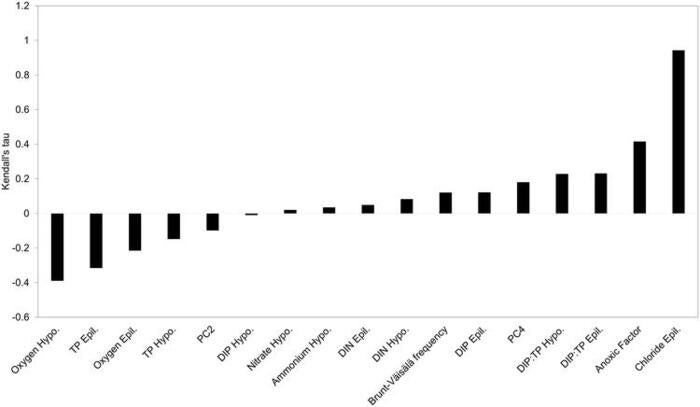Contact
![]()
 Philippe Van Cappellen, Department of Earth and Environmental Sciences
Philippe Van Cappellen, Department of Earth and Environmental Sciences
Introduction
Urbanization and associated land use change is a global phenomenon with often negative impacts on water quality and aquatic ecosystems. In particular, urban development of watersheds has been blamed for worsening eutrophication in receiving lakes and wetlands. Increased loadings of nutrients, especially of phosphorus (P), are generally assumed to be the main driver of eutrophication. A high availability of P stimulates dense algal growth that, in turn, may severely deplete dissolved oxygen (DO). In the worst case, the development of a so-called anoxic “dead zone” may result in die-offs of most organisms, such as fish and plants.
In cold temperate regions, urbanization is typically accompanied by growing winter applications of deicing road salts that inevitably lead to the salinization of local waterways, lakes, and groundwater aquifers. A direct link between salinization and eutrophication of lakes has not yet been demonstrated, however. This study investigates water quality changes in a Canadian lake over a two-decade period. The long-term multi-variate dataset is used to delineate and explain general trends in water quality using a variety of statistical methods. The main outcome is that rising salinity is responsible for the observed intensification of eutrophication-like symptoms, with very low DO levels in the deeper waters of the lake persisting over increasingly longer periods of time during the year. Yet, no evidence was found for an increase in the external loading of P from the watershed to the lake.
Methodology
Lake Wilcox is a small kettle lake located in Richmond Hill, Ontario with a watershed area of 2.39 km2 (Figure 1). The originally forested watershed has undergone significant development since the early 1900s when the land was converted to agriculture, followed by urban development since the 1980s. As a result, land surface imperviousness is now over 60% (Figure 2a). In the 1980s, harmful cyanobacteria became an issue and an aeration system was installed but later deactivated. In the early 2000s, several stormwater management (SWM) systems were installed in the lake’s catchment to address deteriorating lake water quality.

Figure 1: Location of Lake Wilcox in Ontario, Canada (a), and sketch of its watershed (b).

Figure 2: Fraction of impervious land cover in Lake Wilcox's watershed (a) and lake surface water chloride concentration (b) from 1996 to 2018. The upward trends in both panels reflect the urban growth in the lake’s watershed.
A variety of datasets for the period of 1996 to 2018 were collected for the study, including water quality monitoring data, climate data, and surveys and satellite images of land use. The dissolved oxygen (DO) time series data served to calculate values for the Anoxic Factor (AF), a measure of the changes in the intensity of deoxygenation of the lake’s deeper waters. Interannual variations in the stability of the water column stratification were assessed by calculating the water density from measured temperature and salinity data and comparing the Brunt-Väisälä or buoyancy frequency depth profiles for the month of August, that is, when the thermal stratification of the lake is highest.
Multiple statistical methods were used to characterize and interpret water quality trends. Temporal changes were assessed with the Mann-Kendall test (Figure 3) and Principal Component Analysis helped to group correlated variables and identify the main drivers of water chemistry changes. A Multiple Linear Regression model was also developed to explore the relationships between the principal components and the following potential predictor variables: watershed imperviousness (as a measure of urbanization), lake chloride (Cl−) concentration (as a measure of deicing salt usage), external P loading to the lake, water column stratification (using the Brunt-Väisälä frequency), and climate parameters (including, measures of temperature conditions and the intensity of extreme precipitation events that can play an important role in pollutant wash-off in urban areas).

Figure 3: Kendall's tau values for Mann-Kendall trend analyses. The figure includes the results for the water quality parameters, explanatory variables in the multiple linear regression analyses, and principal components (PCs) that show a statistically significant (p ≤ 0.1) trend with time over the period 1996 to 2018. Note that positive (negative) tau values indicate increasing (declining) trends over time. Hypo = hypolimnion, Epi = epilimnion.
Outcomes
Although the external P inputs to Lake Wilcox have been generally declining, the lake is showing increasing eutrophic symptoms, most visible by the lengthening of the annual period during which the lower part of the lake (i.e., the hypolimnion) experiences low DO concentrations (i.e., hypoxic to anoxic conditions). The chloride concentration (and, hence, salinity) trend was explored as a potential explanatory variable because of the large increase in the lake water Cl− concentrations (Figure 2b) at the same time hypoxia expanded (Figure 4).
During the study period, the water chemistry of Lake Wilcox underwent significant changes, especially in terms of the concentrations of Cl−, DO, total phosphorus (TP), and dissolved inorganic P (DIP). Changes in the ratios DIP:TP and DIN:DIP ratios (where DIN refers to dissolved inorganic nitrogen) were also observed. Chloride concentrations increased by a factor of 4, likely due to the increasing application of deicing agents as the watershed urbanized and connectivity to stormwater management infrastructure increased. While the results revealed decreasing trends for the external TP load to the lake and the TP concentrations in the lake, they showed little change in the DIP concentration, meaning that the lake DIP:TP ratios increased over time. This is important because DIP represents the most bioavailable fraction of TP. The longer annual periods of DO depletion of the hypolimnion and the corresponding increase of the AF likely intensified the P loading from the bottom sediments to the water column. It is well known that recycling of P from sediments, also known as internal P loading, is more efficient when the overlying water is anoxic.
The results of the study show that the increasing salinity of Lake Wilcox due to the growing impervious land cover and accompanying increase in road salt application in the watershed has led to a strengthening of the lake's water column stratification. In turn, this has increasingly isolated the hypolimnion from the atmosphere and, hence, accelerated the depletion of DO and amplified the role of internal P loading, relative to the external loading. These changes in DO and P cycling are common symptoms of eutrophication. In Lake Wilcox, however, they appear to be more linked to the lake’s progressive salinization than to a higher external loading of P from the watershed.

Figure 4: Mid-lake depth distributions of dissolved oxygen concentrations (DO) between 1996 and 2018. Note the significant lengthening of the yearly period of anoxia (blue color) after 2003.
Conclusions
By increasing water density and stabilizing the stratification of the water column, salinity emerges as a major driver of changes in water quality in Lake Wilcox. These changes include the expansion of hypoxia and anoxia in the hypolimnion and the increased contribution of internal loading to the lake’s P budget. This is the first known study that directly links salinization with lake eutrophication symptoms.
Salinization, in addition to climate warming, may be an overlooked driver of downward trends of hypolimnion DO concentrations in lakes worldwide. In cold-temperate regions, urbanization is usually accompanied by increased application of road salts as indicated by rising Cl− concentrations observed in urban lakes of North America and northern Europe. The study further suggests that efforts to reduce eutrophication of water bodies in urbanizing areas by controlling external nutrient loadings may be offset by the enhanced internal P loading as DO depletion intensifies.
Historical use of road salt in urban watersheds also created chloride legacies in soils and groundwater. These legacies could continue to supply excess Cl− to receiving lakes even if winter salt applications were reduced or altogether halted. Protecting the health of urban lakes therefore calls for integrated management strategies and requires further work to understand the contributions of climate change, urbanization and salinization, and their interactions, to changes in lake water quality.
Radosavljevic, J., Slowinski, S., Shafii, M., Akbarzadeh, Z., Rezanezhad, F., Parsons, C. T., Withers, W., Van Cappellen, P. (2022). Salinization as a driver of eutrophication symptoms in an urban lake (Lake Wilcox, Ontario, Canada). Science of The Total Environment, 846, 157336. doi.org/10.1016/j.scitotenv.2022.157336
For more information about WaterResearch, contact Julie Grant.
Banner photo by Pavel Neznanov on Unsplash






